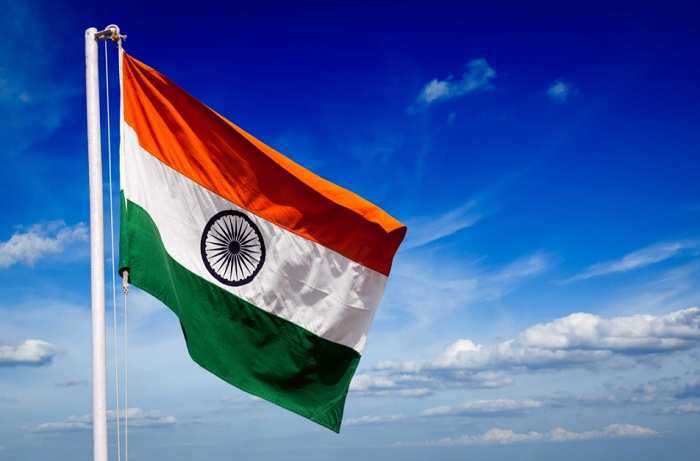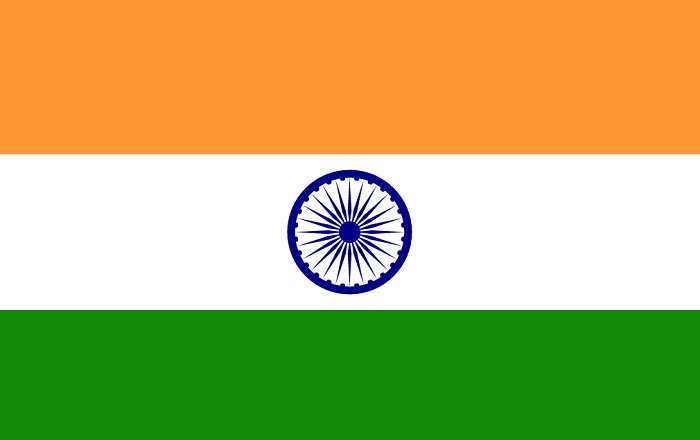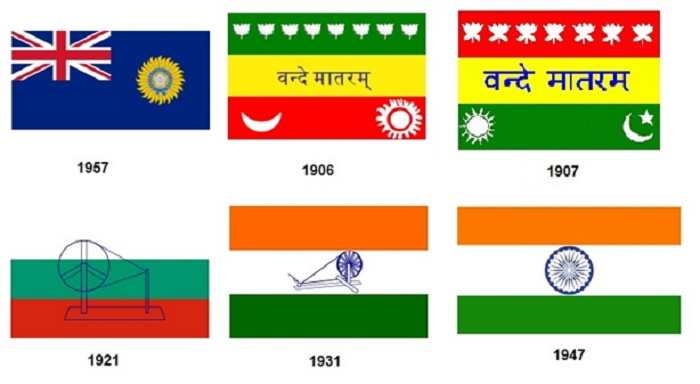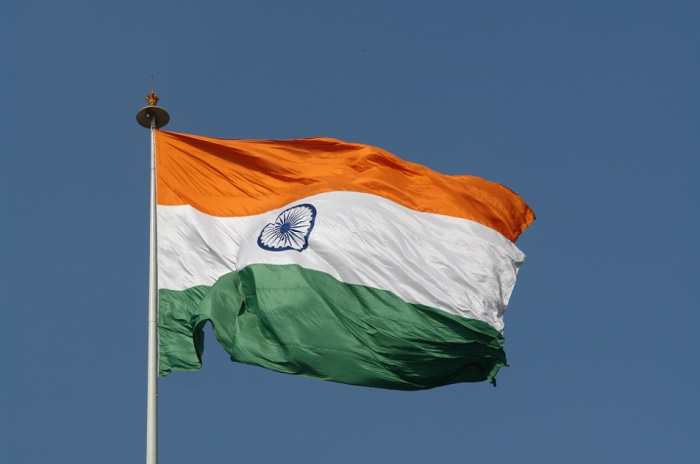Title: Tricolour / Tiranga
Colors: Saffron, White and Green; Navy Blue in the Askoka Chakra
Dimension ratio: 2:3
Material: Khadi Cotton or Silk
Adopted on: July 22, 1947
Designed by: Pingali Venkayya
Manufactured by: Khadi Development and Village Industries Commission

Mahatma Gandhi said, ‘A flag is a necessity for all nations. Millions have died for it. It is no doubt a kind of idolatry which would be a sin to destroy. For, a flag represents an Ideal.’ The national flag is the banner that imparts a nation its own unique identity, proclaims to world of its sovereignty, and announces the principles on which lies the country’s foundation.
The National flag of India is rectangular in shape and consists of three colors – saffron, white and green. The present form of the flag was adopted by the Constituent Assembly of India on 22 July, 1947 - 24 days prior to the formal declaration of Independence.
Design
The rectangular tricolor flag consists of three equal horizontal segments, with saffron on top, white in the middle and green at the bottom. At the center of the white stripe is a depiction of Ashok Chakra in navy blue. It is round hollow wheel and has 24 spokes radiating from the center. The RGB values for referring to the colors of the Indian National flag are India saffron #FF9933, white #FFFFFF, India green #138808, and navy blue #000080. The dimension of the flag should be of 2:3 ratio, i.e. the length should be 1.5 times the breadth. The flag is to be made from Khadi, hand-woven cotton or silk, following the manufacturing protocols laid out by the Bureau of Indian Standards (BIS). The Khadi Development and Village Industries Commission hold the right to manufacture the Indian National flag and as of 2009, the responsibility lies with the Karnataka Khadi Gramodyoga Samyukta Sangha.

Symbolism
The colors and symbols of the Indian National flag hold deep philosophical meaning. Each color represents a specific aspect of Indian culture that resonates deeply within the hearts of the citizens. The saffron stands for sacrifice and renunciation, the white stands for peace and the green stands for courage and immortality. The Ashok Chakra is a depiction of Dharma Chakra. It has 24 spokes radiating from the center. It represents righteousness, justice and forwardness. The symbolism of wheel is that of constant movement that heralds progress and repels stagnation.
Another underlying symbolism of the three colors is based on the secular principles of India as a country. The saffron represents Hinduism, Buddhism and Jainism, the white is for Christianity and the green stands for Islam. The flag as a whole represents a confluence of all religious principles, but above all a philosophy of tolerance and righteousness as depicted by the Ashok Chakra in the middle.
Philosopher and Vice President of India, Dr. Sarvapalli Radha Krishnan put forward to the world the interpretation of the Indian Flag in an eloquent expression, “Bhagwa or the saffron colour denotes renunciation or disinterestedness. Our leaders must be indifferent to material gains and dedicate themselves to their work. The white in the centre is light, the path of truth to guide our conduct. The green shows our relation to (the) soil, our relation to the plant life here, on which all other life depends. The "Ashoka Chakra" in the centre of the white is the wheel of the law of dharma. Truth or satya, dharma or virtue ought to be the controlling principle of those who work under this flag. Again, the wheel denotes motion. There is death in stagnation. There is life in movement. India should no more resist change, it must move and go forward. The wheel represents the dynamism of a peaceful change”

Evolution of the Indian Flag
Prior to the Sepoy Mutiny in 1857, the fragmented nation of India was represented by the individual flags of the various princely states. Post the Sepoy Mutiny, the British established Imperial rule in India and a flag was introduced to represent the British colony of India. The flag was blue, with the Union Jack on the upper left corner, and a star enclosed by a crown on the down right corner.
The first unofficial flag to be hoisted by the Indians happened on August 7, 1906, in Parsee Bagan, Calcutta. The rectangular flag consisted of three horizontal stripes of green, yellow and red from top to bottom. The uppermost green segment contained 8 lotuses representing 8 provinces, the middle yellow segment bore the words Bande Mataram in Sanskrit and the bottom red band had a crescent on the left and a sun on the right hand side.
A slightly modified version of the previous flag was hoisted in 1907 by Madame Cama and her group of exiled revolutionaries in Paris. The uppermost strip had 7 lotuses instead of 8 and it was the first time the color saffron was used in the flag.
In the next decade, several other concepts for the flag were proposed but they did not gain popularity. In 1921, Gandhi proposed a tricolored flag with the symbol of the spinning wheel at its center. The colors of the flag represented the dominant religions of the Indian subcontinent with clear message of promoting religious harmony. But growing demands for further modification led him to change the interpretations of the colors into something more secular. The lowermost strip of red represented sacrifice, middle green stripe represented hope and the topmost white stripe represented peace.
The version of the flag closest to the current one came into existence in 1923. It was designed by Pingali Venkayya and had the saffron, white and green stripes with the spinning wheel placed in the white section. It was hoisted on April 13, 1923 in Nagpur during an event commemorating the Jallianwallah Bagh Massacre. It was named the Swaraj Flag and became the symbol of India’s demand for Self-rule led by the Indian National Congress.
The resolution to adopt the tricolor as the National Flag of India was passed in 1931. On July 22, 1947, the Constituent Assembly of India adopted the Swaraj Flag as the National Flag of Sovereign India with the Ashok Chakra replacing the spinning wheel.

Protocols for Displaying the Indian National Flag
The Flag Code India (2002), Prevention of Improper Use of Emblems and Names Act (1950), and the Prevention of Insults to National Honour Act (1971) govern the display, representation and handling of the Indian National Flag. The Do’s and Don’ts of handling the Indian National Flag are as follows:
1. The national flag should be displayed upright with the Saffron strip facing the top in horizontal representations and left in the vertical representations. The flag should never be displayed upside down.
2. The Flag should be displayed on the right as this is the position of authority when indoor.
3. When carried in a procession the National Flag should be borne by marching right or otherwise by a lone marcher in the center.
4. The flag cannot be used as drapery or clothing.
5. The flag should be hoisted down prior to sunset and erected again after sunrise.
6. The flag pole for National Flag should be placed at the highest point of the building.
7. Private institutions may display the national flag on all days and occasions, ceremonial or otherwise, consistent with the dignity and honor of the National Flag.
8. Post amendment of the Flag Code in 2002, Individual citizens may also hoist/display the Indian National Flag in their premises
9. The flag may be flown half-mast as a sign of mourning the decision of which lies with the President of India.
10. The National Flag of India must be displayed on Republic Day (January 26), Independence Day (August 15), Gandhi Jayanti (October 2), State formation Anniversaries and National Week.
11. On the occasion of armed forces personnel funerals the National flag should be draped over the coffin, with the saffron towards the head. However, the National Flag should never be lowered into the grave or burnt in the pyre.
12. Soiled National Flag may be disposed as a whole in private preserving the dignity of the same and should not be done disrespectfully.
Significance of the National Flag
The National Flag of India represents the concept of secularism that the country was built upon. The austerity of the rectangular tricolor underlines the rich spiritual and philosophical history of India. The basis of the flag is the Swaraj Flag, adopted by the Indian National Congress during the Indian Freedom Struggle movement under Gandhi and is reminiscent of the same.



